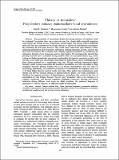Por favor, use este identificador para citar o enlazar a este item:
http://hdl.handle.net/10261/59858COMPARTIR / EXPORTAR:
 SHARE SHARE
 CORE
BASE CORE
BASE
|
|
| Visualizar otros formatos: MARC | Dublin Core | RDF | ORE | MODS | METS | DIDL | DATACITE | |

| Campo DC | Valor | Lengua/Idioma |
|---|---|---|
| dc.contributor.author | Fedriani, José M. | - |
| dc.contributor.author | Zywiec, Magdalena | - |
| dc.contributor.author | Delibes, M. | - |
| dc.date.accessioned | 2012-11-08T12:15:44Z | - |
| dc.date.available | 2012-11-08T12:15:44Z | - |
| dc.date.issued | 2012 | - |
| dc.identifier | doi: 0.1890/11-0429.1 | - |
| dc.identifier | issn: 0012-9658 | - |
| dc.identifier.citation | Ecology 93: 575- 587 (2012) | - |
| dc.identifier.uri | http://hdl.handle.net/10261/59858 | - |
| dc.description.abstract | The persistence of mutualisms despite the strong incidence of exploiters could be explained if exploiters deny one or more services (i.e., cheat) while eventually supplying some subtler but critical services. Pulp feeders usually ingest fruit reward without dispersing seeds and thus are considered to be mainly cheaters or thieves of seed-disperser mutualisms. By consuming the fruit pulp, however, they could release seeds from pulp inhibitory effect, enhancing germination and, potentially, subsequent seedling emergence, growth, survival, and thus local recruitment. We evaluated such a largely neglected hypothesis by considering the interaction between Pyrus bourgaeana and its pulp feeders. We experimentally showed that pericarp removal had a consistent strong positive effect on seed performance (e.g., lower rotting and higher germination percentages) and seedling fate (greater emergence, growth, and survival to two years old). Interestingly, these relatively large positive effects of depulpation on plant fitness persisted for a surprisingly long time. Though seedlings experienced higher mortality under fruiting conspecifics, the benefits of depulpation were not overridden by high propagule mortality beneath fruiting trees or in adverse microhabitats after two years of monitoring. Specifically, the cumulative probability of establishment for depulped seeds was 4–25 times higher than for seeds in whole ripe fruits. Thus, under some circumstances, pulp feeders can provide essential services to endozoochorous plants. Our study contributes to clarifying the apparent paradox of plant–frugivore mutualisms that persist in the face of exploitation by pulp feeders. Because “thieves” and “mutualists” refer to the extremes of a complex continuum, and because organisms displaying concurrent cheating and honest behaviors during different host stages are likely prevalent, the persistent language of mutualists vs. thieves, cheaters, or exploiters might be misleading. Read More: http://www.esajournals.org/doi/abs/10.1890/11-0429.1 | - |
| dc.language.iso | eng | - |
| dc.publisher | Ecological Society of America | - |
| dc.rights | openAccess | - |
| dc.title | Thieves or mutulists? Pulp feeders enhance endozoochore local recruitment. | - |
| dc.type | artículo | - |
| dc.identifier.doi | 0.1890/11-0429.1 | - |
| dc.date.updated | 2012-11-08T12:15:45Z | - |
| dc.description.version | Peer Reviewed | - |
| dc.type.coar | http://purl.org/coar/resource_type/c_6501 | es_ES |
| item.cerifentitytype | Publications | - |
| item.openairecristype | http://purl.org/coar/resource_type/c_18cf | - |
| item.grantfulltext | open | - |
| item.openairetype | artículo | - |
| item.fulltext | With Fulltext | - |
| item.languageiso639-1 | en | - |
| Aparece en las colecciones: | (EBD) Artículos | |
Ficheros en este ítem:
| Fichero | Descripción | Tamaño | Formato | |
|---|---|---|---|---|
| ecology.pdf | 582,19 kB | Adobe PDF |  Visualizar/Abrir |
CORE Recommender
Page view(s)
262
checked on 29-abr-2024
Download(s)
97
checked on 29-abr-2024
Google ScholarTM
Check
Altmetric
Altmetric
NOTA: Los ítems de Digital.CSIC están protegidos por copyright, con todos los derechos reservados, a menos que se indique lo contrario.
